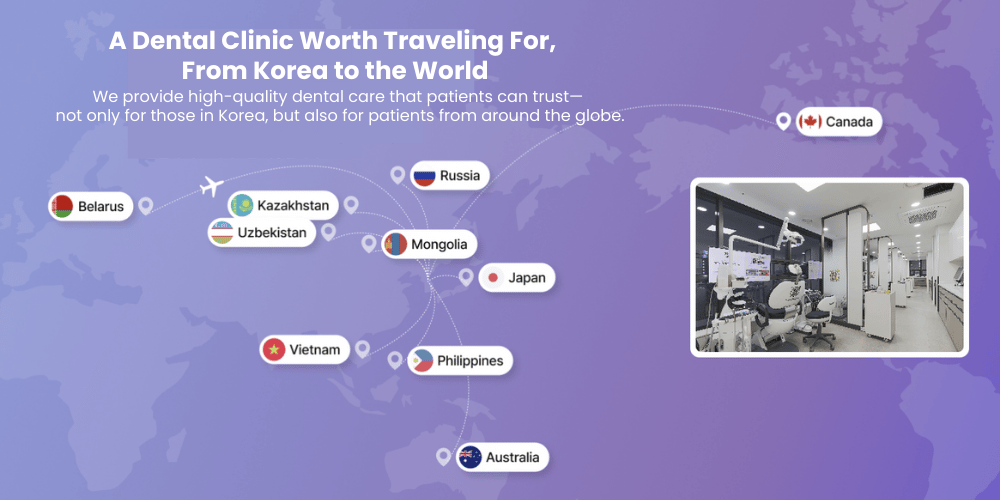Root Canal Treatment at 365 Seoul One Top Dental Clinic(Gangseo, Mokdong, Yeongdeungpo)
365 Seoul One Top Dental Clinic provides comfortable, accurate root canal therapy for infected or damaged teeth using digital diagnostics, rotary endodontic systems, and pain-reduction techniques. Patients in Gangseo-gu and throughout Seoul choose the clinic for its gentle approach, efficient workflow, and 365-day availability that supports urgent dental care needs.
Why Choose 365 Seoul One Top Dental Clinic for Root Canal Treatment
Digital X-Ray & 3D Imaging Accuracy
High-resolution imaging identifies infection depth, canal shape, and surrounding bone conditions for precise treatment planning.
Modern Rotary Endodontic Technology
Rotary instruments provide cleaner canal shaping, shorter procedure times, and improved long-term success compared to manual methods.
Pain-Minimizing Techniques
Local anesthesia, advanced irrigation systems, and careful instrumentation help reduce discomfort during and after treatment.
Open All Year — 365 Days
Evening weekday hours plus weekend and holiday service allow fast access for patients experiencing tooth pain or swelling.
Types of Root Canal Services Offered
Standard Root Canal Therapy
Removes infection from inside the tooth, disinfects the canals, and seals the root for long-term protection.
Retreatment / Re-do Root Canal
For teeth that have persistent infection or failed previous treatments, retreatment can restore function and reduce discomfort.
Root Canal + Crown Restoration
After treatment, the tooth can be strengthened with a ceramic or zirconia crown for improved durability.
Emergency Pain Relief & Drainage
Immediate management for severe toothache, swelling, or abscess situations.
Single-Visit Root Canal (Case-Dependent)
When clinically appropriate, treatment may be completed in one session.
Your Root Canal Process: Step-by-Step
1. Examination & Diagnostic Imaging
Digital X-rays or 3D scans confirm inflammation, infection depth, and root canal anatomy.
2. Local Anesthesia & Access Preparation
The tooth is numbed, and a small opening is created to access the canals.
3. Cleaning & Disinfection
Rotary files remove infected tissue, followed by thorough irrigation and sterilization.
4. Sealing the Root Canals
Biocompatible material fills the canals to prevent future infection.
5. Restoration & Crown Placement
Because root-treated teeth weaken over time, a crown is often recommended for long-term stability.
6. Follow-Up Care
Routine check-ups ensure the treated tooth remains healthy and functional.
Who Needs Root Canal Treatment?
- Persistent toothache or sensitivity
- Pain when biting or chewing
- Deep decay reaching the nerve
- Cracked or traumatically injured teeth
- Swelling or abscess near the tooth
- Previous failed root canal requiring retreatment
Additional Dental Services at 365 Seoul One Top Dental Clinic
Dental Crowns
Durable ceramic and zirconia crowns to protect root-treated teeth.
Veneers & Cosmetic Dentistry
Smile enhancement through laminates, whitening, and gum contouring.
Orthodontics
Corrective alignment solutions for teeth crowding or bite issues.
General Dentistry
Fillings, scaling, periodontal therapy, and wisdom tooth removal.
Dental Implants
Digital implant placement, bone grafting, and full-arch solutions.
Location & Hours
Clinic Name:
365 Seoul One Top Dental Clinic (365서울원탑치과의원)
Address:
3F, Dongmyeong M Building
179 Gangseo-ro, Gangseo-gu, Seoul, South Korea
Phone: 010-2762-3828 (WhatsApp Available)
Hours:
- Mon–Fri: 09:30–20:00
- Weekends & Holidays: 09:30–17:00
- Lunch Break: 12:30–14:00
- Open 365 Days
How to Book a Root Canal Consultation
Patients can call the clinic or submit a simple online reservation request with their contact details and symptoms. The team will assist with scheduling and any urgent care needs.




